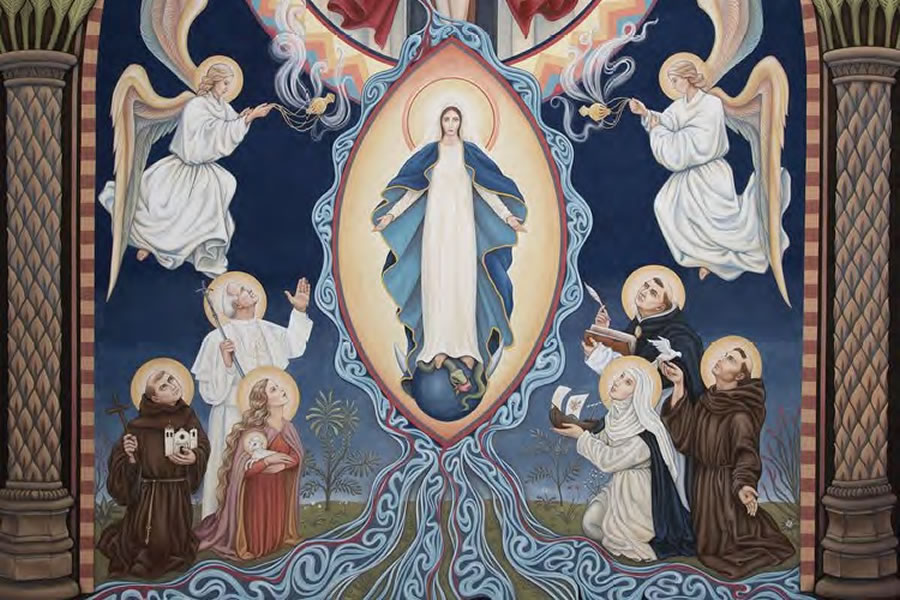
Our Temporary Altar Backdrop
by Fr. Chris Axline | 04/03/2022 | Weekly ReflectionOver the past few weeks I’ve been getting lots of questions about our backdrop. Thank you for your interest and for engaging with the sacred art. One of the great historical means the Catholic Church has used to teach the faith is through sacred art (murals, frescoes, stained glass windows, etc.).
Continuing in that tradition it is with great joy that in this week’s article that Geoff and Ruth Stricklin of New Jerusalem Studios give us an explanation of the piece and all the symbolism contained therein. Ruth designed and made this piece and she is the artist that will be painting our sanctuary space in the months to come. Her description is below:
The artwork is of a large scale mural painted by Ruth Stricklin of New Jerusalem Studios, on the occasion of the centennial year, 2017 of St. Mary’s High School, Phoenix. Entitled Christ’s Eternal Sacrifice and Mary Mediatrix of All Grace, this piece was commissioned by the school’s President- Rector, Father Robert Bolding, for use in all-school masses held in its gymnasium. To accommodate the multifunctional nature of the gym, the mural is painted in the format of a high-quality theatrical backdrop that can be rolled and unrolled, transported and stored. It measures 20 feet wide by 25 feet high, and features Christ Crucified and ascended to Glory with Mary, Queen of Heaven at the center of the restored cosmos, surrounded by adoring angels, reminiscent of the cherubim of the Arc of the Covenant and Solomon’s Temple in the Old Testament. Mary is the perfect, sinless vessel and new tabernacle of Christ, and Christ is the new Temple.

It is painted in a style influenced by the Beuronese Schooltwo dimensional stylized figures, characterized by emotional restraint, muted colors, and foundation in sacred geometry. A suggestion of the Temple and the Holy of Holies is seen behind the figure of Christ, as Christ is the new Temple, and one can also see the torn veil represented in red to show the sacrifice, the tearing of his own body, signifying the end to Old Testament sacrifice and the beginning of worship in spirit and truth. The blood and water pour from his side, which is the birth of the church, and the streams of living water flow out, as in the vision of Revelation, nourishing the garden of the heavenly Jerusalem, the restored Garden of Eden, and all the subjects in the kingdom of heaven.
Mary is depicted alone at the foot of the cross, for she was bound to Christ in a singular way and suffered with him like no other. She is shown in the garments and posture of the Immaculate Conception, yet she also wears the dark cloak of Our Lady of Guadalupe, suggesting that she is with child. She stands as the woman in Genesis, with her foot on the head of the serpent and her head crowned with 12 stars. As the heavenly Jerusalem has 12 gates, she is the gateway to the graces of Christ. As our first mother, Eve, led to the fall of all mankind, Mary’s willingness to participate with God’s grace led to the restoration of humanity and the undoing of the Fall through Christ’s sacrifice. She is the new Eve, standing at the foot of the new Tree of Life, the Cross.
The setting is the Heavenly Jerusalem. Stylized palm trees presented as columns in the heavenly city, a field filled with stars, and geometrically perfected plants and flowers evoke a restored cosmos and Garden of Eden. God the Father and the Holy Spirit are depicted with Christ in symbolic form as the triangle within the circle indicating Unity in Trinity and attended by the 6 winged seraphim, aflame with tones of red and orange as they are the closest to the throne of God. The saints featured are St. Junipero Serra, St. John Paul II, and St. Agnes on the left, with St. Catherine of Siena, St. Thomas Aquinas and St. Francis of Assisi on the right. Each is holding an object symbolic of their ministry on earth or martyrdom, which helps identify them in sacred art representations.
Ruth Stricklin and her husband, Geoffrey Stricklin, a graduate of the Liturgical Institute, Mundelein, IL, formed New Jerusalem studios in 2014 in response to a growing commitment to authentic liturgical renewal, especially seen in their own Diocese of Phoenix under the visionary leadership of Bishop Thomas Olmsted. The mission of New Jerusalem Studios is evangelization through beauty. It aims to produce works that accomplish the vision of liturgical art set forth by the Second Vatican Council, that “truly sacred art should strive after noble beauty,” (SC 124); radiantly revealing and making present to the senses, the grand mysteries celebrated in liturgy. New Jerusalem Studios is involved in multiple projects of church renovation and sacred art in the Diocese of Phoenix and around the country. Please visit New Jerusalem Studios at www.njerusalemstudios.com.
Thank you Geoff and Ruth for that explanation! Thank you for helping us enter more fully into the mystery and sacrifice of the Mass through this beautiful work of art. I hope their explanation helps all of us enter more fully into the Mass and to contemplate God and inspire us to greater sanctity! If you’d like to learn more about Geoff and Ruth’s work please visit their website (https://njerusalemstudios.com/) and learn more about their mission and the work they’ve done with several parishes within the Phoenix diocese.
BACK TO LIST BACK